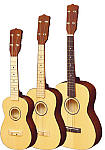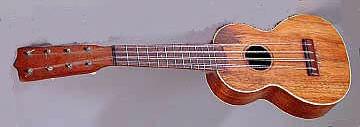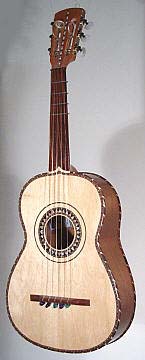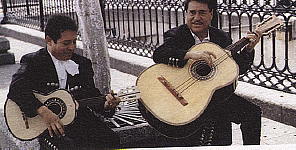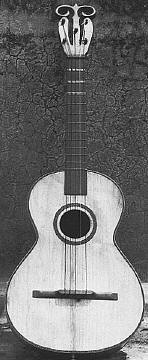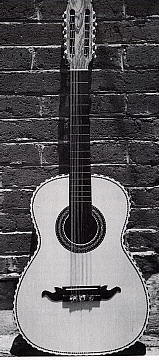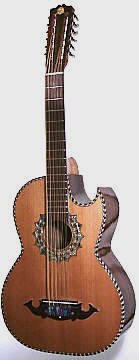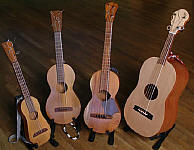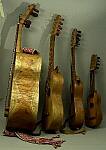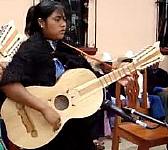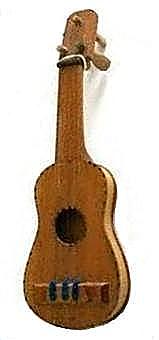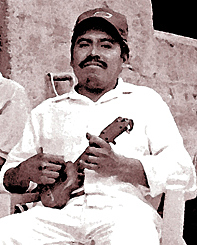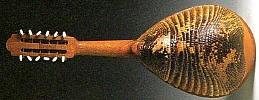| North America | ATLAS of Plucked Instruments |
| •
HOME • about • collection • books • index • links • lutes • guitars early • guitars modern • mandolins • cittern • banjos • steelguitars • miscellaneous • Europe West • Europe East • Europe South • Africa • Middle East • Central Asia • India • Far East • S.E. Asia • America N • America C • America S
|
North America In Canada and USA
(including Hawaii) we find mainly the instruments
already mentioned in the general historical chapters : (acoustic and
electric) guitars, mandolins, banjos, dulcimers, etc.
Mexico is the ultimate source for plucked stringed instruments : a very wide variety of different models and sizes; and in most of them you can still recognize the original smaller size European guitars of the 17th century, with 5 strings or double courses.
|
| top | USA (incl. Hawaii) | ||||||||||||
|
In the United States
plucked stringed instruments are quite popular and are used in typical
American style music :
|
|||||||||||||
| top | |||||||||||||
|
ukulele The ukulele is the small guitar of Hawaii. It originated from the rajão (the tuning) and braguinha (the size) of Madeira (see page EuropeWest), which both arrived on the islands in 1879. The ukulele (also spelled ukelele) was soon very popular. After the Hawaiian music reached the USA during the 1920's (together with the Hawaiian guitar) a few million of these instruments were made. The instrument is made like a small guitar, and the better (more expensive) ones are made from koa wood. But even the cheap plastic ones are said to produce an acceptable sound. The tuninghead usually is flat, with friction pegs or
machine tuners, and some instruments have a guitar-like head. The body
shape can look like a spanish guitar, a mandolin,
a pineapple, a sigarbox, etc. The fingerboard is slightly raised above
the soundboard. The bridge is guitar-like and fixed to the front.
|
||||||||||||
| top | |||||||||||||
|
taropatch The taropatch (or taro patch) is a ukulele with double strings, so 8 strings in 4 courses. The name comes from Madeira, where the rajão was often taken to the ricefields (the "taro-patch") and therefore nicknamed : "taro-patch fiddle". When after the arrival on Hawaii the rajão fell in disuse, the name was used for the double string ukulele. The size in the 1920 was usually like the concert ukulele, but recent models seem to favour the larger tenor ukulele. Similarly the original flat peghead with friction pegs has nowadays been replaced by a guitar-like tuning head. The taropatch with 8 nylon strings has the two top strings in unison and the two bottom strings in octaves. The tuning is like the ukulele : gg' cc' e'e' a'a'. A similar 6-string ukulele exists, which has
only two strings double (first and third course) - see under ukulele
above.
____________________________________________________________________ In case you expected to find Hawaiian guitars here : see page steelguitars. Apparently it is nowadays difficult to find the original Hawaiian guitars on Hawaii - the slack key guitar is now the most popular national instrument. This is a normal (usually steel string flat top) guitar, with an open tuning, on which traditional Hawaiian tunes are played. |
||||||||||||
| top | |||||||||||||
|
tiple
In the wake of the popularity of the ukulele,
the Martin guitar factory made in the 1930's (until 1960's) a small
guitar (the size of a tenor ukulele), with steel strings
- which was influenced by a South American folk guitar, the
tiple [pronounced "tea-play"]. The tiple is made like a small guitar. The tuning head could be flat (with machines from behind), or slotted (like a classical guitar). The bridge is often a bit larger (rounded on the lower side), probably to have a larger glue surface area for the higher pulling force of 10 steel strings. The tuning could be like a guitar : aa' d'dd'
f#'f#f#' b'b'.
|
||||||||||||
| top | Tahiti | ||||||||||||
|
Tahitian ukulele There is also a Tahitian version of the ukulele,
which is quite different from the traditional model. It has been developed
since the 1990's. The flat tuning head is usually wider on the top, with tuning machines from behind, 4 on each side. The frets are metal, inlayed in the neck. The fingerboard is flush with the front. The Tahitian ukulele has usually 4 courses of
thin nylon strings (often bright yellow fishlines of the same thickness),
and is tuned like the normal ukulele : The sound of the Tahitian ukulele is sharp, and a bit like an old banjo. So sometimes it is referred to as the Tahitian banjo.
|
||||||||||||
| top | Mexico | ||||||||||||
|
vihuela
Mexico has a very wide variety of guitar-like instruments. The most well known ones are used in the Mariachi music style, which includes also trumpets, violins, guitarron (bass guitar), etc. The vihuela is a guitar-like instrument, but slightly smaller (3/4). The back of the body is made in a rather high (almost triangular) vault. Around the edges of front and back are thick strips of rounded purfling. The fingerboard is flush with the front, and it has usually
only 4 tied-on nylon frets. The peghead is flat, and nowadays always
has guitar-style tuningmachines. It has 5 nylon strings in a re-entrant tuning : a d' g' b e' . Playing is in a typical strumming style with a combination of threes and two's.
|
||||||||||||
| top | |||||||||||||
|
guitarrón
The guitarrón is the (acoustic) bass guitar of the Mariachi orchestra. It is sometimes also called guitarrón de Toloche. The instrument is made like a huge vihuela, so with a high vaulted back and thick round strips around the edges. It has no frets. The 6 thick nylon strings are always plucked two strings (octaves) at the same time. The tuning is A' D G c e A - (notice the top A is lower than the third string).
In Chile you can also find a guitarrón, but that is a completely different instrument, with not less than 25 strings ! (see page South America). |
| top | |||||||||||
|
guitarra
de golpe / guitarra colorada / quinta
de golpe
The 5 nylon strings could be tuned like : d g c' e a (note the hight 3rd). |
||||||||||
| top | |||||||||||
|
guitarra
doble The guitarra doble was
the Mexican 12-string guitar, with all strings double - and
in unison (so not like our 12-string guitar, with some strings
in octaves). Nowadays the name "guitarra doble" is used for a guitar with a double neck. The normal 12-string guitars (any type) are
now called docerola.
|
||||||||||
| top | |||||||||||
|
bajo
sexto / bajo quinto
This is the 12-string bass guitar used in the Mexican country music, a kind of TexMex. It differs from the guitarro doble by having octave strings in the 3 lower courses, and is tuned a whole octave lower. There is also a bajo quinto, which has 5 double strings - the low 6th course is taken away, as apparently it is hardly ever used on a bajo sexto anyway. The bajo sexto guitar is made like a normal guitar, with a flat back. Usually it has a cut-out, and decorative extensions to the bridge. Often there is extra decoration around the soundhole and around the edge of the body. The fingerboard is raised above the front. It has normal guitar frets. The tuning is a like a 12-string guitar, but one octave deeper (!), so the lowest stings are really like a bass guitar. The left string of the course is the high octave: EE' AA' dD GG cc ff. Playing is with a combination of bass notes and strumming to give the rhythm basis for the music.
Note that on YouTube this music seems mainly played by kids, using also an harmonica. |
||||||||||
| top | |||||||||||
|
requinto
This is the smaller Spanish guitar, used in the bambuco music style (also called romantico), in a trio including also a Spanish guitar and a standing bass. The requinto is made like a small size (85%)
Spanish guitar, tuned 5 pitches higher (topstring in a') than
a normal guitar. It is used to play the solos, often using a plectrum.
|
||||||||||
| top | |||||||||||
|
huapanguera
Around the town of Vera Cruz (in East Mexico) some different
styles of music are in use. One of them is the son huasteco
music. This is played with three instruments : the violin,
the (big) huapanguera guitar and the small jarana huasteca
guitar. The huapanguera is made like a guitar (with
a body shaped somewhat between a spanish guitar and a jumbo
guitar) with a flat back, and quite deep. The round open soundhole
has often inlayed mother-of-pearl decoration It has usually 8 nylon strings in 5 courses, the 1st and 5th being single, the rest double. A tuning could be : G dd' gg bb e (note the low first string and the G at the 5th !). The huapanguera is strummed and provides the bass for the music.
|
||||||||||
| top | |||||||||||
|
jarana
huasteca
In the son huasteco music style from around Vera Cruz a musical trio plays besides the violin and the huapanguera guitar, this small size guitar : the jarana huasteca. The jarana huasteca is made like a small guitar
(about the size of a tenor ukulele), with a flat back, and
quite deep. The bridge (glued to the front) has usually some extension
in the shape of cowhorns (like the huapanguera). The round
open soundhole has often inlayed mother-of-pearl decoration. This jarana has 5 nylon strings in the unusual tuning : g b d' f#' a' . It is played with a special golpe effect.
|
| top | ||||||||||||||||||
|
jarana jarocha
|
|||||||||||||||||
| top | ||||||||||||||||||
|
guitarra
de son /requinto jarocho In the son jarocho music style from around Vera Cruz they use (besides the harp and the jarana jarocha) this smaller size guitar : the guitarra de son, which is also called requinto jarocho. This instrument is made like the jarana jarocha, so the body, neck and tuning head is carved from one piece of wood, and the body is rather shallow. The front is a thin piece of wood; it has a slightly raised fingerboard and veneer on the front of the tuning head. It has 12 or more guitar-like frets (often not higher than the body/neck join). Usually the front is quite plain : no rosette or purfling. The guitarra de son has 4 (or 5) thick nylon
strings. It is played with a plectrum made of horn, usually melody and bass lines in a kind of staccato syncopated style - which must be quite difficult to do as the player often is also the leadsinger of the group.
|
|||||||||||||||||
| top | ||||||||||||||||||
|
guitarra
chamula The guitarra chamula is quite a large guitar, used mainly in the area of San Juan Chamula in Chiapas (South Mexico), during festivals. The guitarra chamula is made like a large guitar, with the top half of the body about the same width as the lower half. The front and the back are overhanging the sides. It has a round soundhole, often with a star-like decoration around it.
The (10 or 12) thin metal strings (all of the same thickness)
run to a bridge glued to the front, with often some extra decoration.
At the bridge all strings have the same distance between them. |
|||||||||||||||||
| top | ||||||||||||||||||
|
cartonal
The cartonal (or cardonal) is probably the smallest guitar in the world. It is used in the Huesteca Potsini region within the ritual life of indigenous communities. There are two different kinds : one with three strings and one with four strings. The cartonal with three strings is the smallest,
and used by the Nahuas, for the Ayacachtinij dance.
|
|||||||||||||||||
| top | ||||||||||||||||||
|
guitarra
conchera
The neck is guitar-like : raised above the front and
with metal frets. The tuning head can be open (with guitar-style tuners),
or flat, with traditional friction pegs (from behind). It is usually played (by strumming chords) by the dancer himself, who has to perform the steps of the dance while playing. It has a loud and singing sound. For more information about the instruments and the music, see Blogspot. |
|||||||||||||||||
|
||||||||||||||||||


